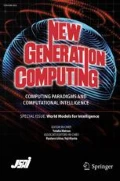Abstract
In this paper we present an extension of PROLOG using modal logic. A new deduction method is also given based on a rule closer to the classical inference rule of PROLOG.
Similar content being viewed by others
References
Aiello, L. and Weyhrauch, R. W., “Using Meta-theoric Reasoning to do Algebra,”Proc. of the 5th Automated Deduction Conf., Les Ares, 1980.
Boolos, G.,The improvability of inconsistance, Cambridge Univ. Press, London, 1979.
Bowen, K. and Kowalski, R., “Amalgamating language and metalanguage in logic programming,” inLogic Programming (K. Clark and S.-Å. Tärnlund, eds.), Academic Press, New York, pp. 153–172, 1982.
Carnap, R., “Modalities and quantification,”J. S. L., Vol. 1 No. 12, 1946.
Clark, K. and Greory, S., “Notes on systems programming in PARLOG,”Proc. of the Int. Conf. on Fifth Generation Computer Systems 1984 (ICOT, ed.), Tokyo, pp. 299–306, 1984.
Colmerauer, A., “Metamorphosis grammars,” inNatural language communication with computer (L. Bolc, ed.), Springer-Verlag, 1978.
Dinebas, M., “The metalog problem solving system: an informal presentation,”Proc. of Logic Programming Workshop, Bebrean, pp. 80–91, July, 1980.
Fariñas del Cerro, L., “A simple deduction method for modal logic,” inInformation Processing Letters, Vol. 14, No. 2, 1982.
Fariñas del Cerro, L., “Resolution Modal logics—Automated reasoning in nonclassical logic,”Logique et Analyse (L. Fariñas del Cerro and E. Orlowska, eds.), Sept., 1985.
Gabbay, D. and Reyle, U., “N-Prolog: An extension of Prolog with hypothetical implication,”Imperial College Report, July, 1984.
Konolige, K., “A Deduction Model of Belief and its Logics,”Ph.D. Thesis, Stanford University, 1984.
Kowalski, R., “Predicate logic as programming language,”Proc. of IFIP pp. 569–574, 1984.
Malachi, Y., Manna, Z. and Waldinger, R., “Tablog: The deductive tableau programming language,”Proc. ACM LISP and Functional Programming Conf., 1984.
Orlowska, E., “Resolution systems and their applications I & II,”Fundamenta Informaticae, Vol. III, No. 2, pp. 235–267 & 333–362, 1980.
Warren, D. S., “Database update in pure Prolog,”Proc. of the Int. Conf. on Fifth Generation Computer Systems (ICOT, ed.), Tokyo, p. 244–253, 1984.
Author information
Authors and Affiliations
About this article
Cite this article
Fariñas Del Cerro, L. MOLOG: A system that extends PROLOG with modal logic. New Gener Comput 4, 35–50 (1986). https://doi.org/10.1007/BF03037381
Received:
Revised:
Issue Date:
DOI: https://doi.org/10.1007/BF03037381


